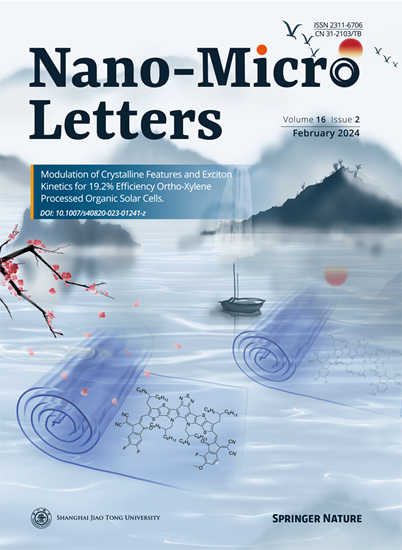具有离域电子区域的量子尺寸FeS2使宽温度下的高性能钠离子电池成为可能。
IF 36.3
1区 材料科学
Q1 Engineering
引用次数: 0
摘要
转换型阳极缓慢的离子插入/扩散动力学严重限制了钠离子电池(SIBs)的宽温度应用。量子级过渡金属二硫族化物具有电荷离域、富集非配位电子和短程转移动力学的独特优势,这对实现低温电荷快速转移和高温界面稳定性至关重要。在此,一个量子尺度的FeS2负载在三维Ti3C2 MXene骨架上(FeS2 QD/MXene)制成SIBs阳极,在宽温度条件下(- 35至65℃)表现出令人印象深刻的性能。理论计算结合实验表征表明,FeS2量子点的不饱和配位边可以诱导离域电子区域,从而降低静电势,显著促进Na+在较宽温度范围内的有效扩散。此外,Ti3C2骨架通过Fe-O-Ti键合增强了结构完整性,同时实现了FeS2 QD的优异分散。正如预期的那样,FeS2 QD/MXene阳极在- 35℃和65℃下,在0.1 A g-1条件下的容量分别为255.2和424.9 mAh g-1, FeS2 QD/MXene//NVP全电池在- 35℃下的能量密度可达到162.4 Wh kg-1,突出了其在宽温度条件下的应用潜力。这项工作扩展了由量子尺寸效应引起的非协调区域,用于在宽温度环境下特殊的Na+离子存储和扩散性能。本文章由计算机程序翻译,如有差异,请以英文原文为准。
Quantum-Size FeS2 with Delocalized Electronic Regions Enable High-Performance Sodium-Ion Batteries Across Wide Temperatures.
Wide-temperature applications of sodium-ion batteries (SIBs) are severely limited by the sluggish ion insertion/diffusion kinetics of conversion-type anodes. Quantum-sized transition metal dichalcogenides possess unique advantages of charge delocalization and enrich uncoordinated electrons and short-range transfer kinetics, which are crucial to achieve rapid low-temperature charge transfer and high-temperature interface stability. Herein, a quantum-scale FeS2 loaded on three-dimensional Ti3C2 MXene skeletons (FeS2 QD/MXene) fabricated as SIBs anode, demonstrating impressive performance under wide-temperature conditions (- 35 to 65 °C). The theoretical calculations combined with experimental characterization interprets that the unsaturated coordination edges of FeS2 QD can induce delocalized electronic regions, which reduces electrostatic potential and significantly facilitates efficient Na+ diffusion across a broad temperature range. Moreover, the Ti3C2 skeleton reinforces structural integrity via Fe-O-Ti bonding, while enabling excellent dispersion of FeS2 QD. As expected, FeS2 QD/MXene anode harvests capacities of 255.2 and 424.9 mAh g-1 at 0.1 A g-1 under - 35 and 65 °C, and the energy density of FeS2 QD/MXene//NVP full cell can reach to 162.4 Wh kg-1 at - 35 °C, highlighting its practical potential for wide-temperatures conditions. This work extends the uncoordinated regions induced by quantum-size effects for exceptional Na+ ion storage and diffusion performance at wide-temperatures environment.
求助全文
通过发布文献求助,成功后即可免费获取论文全文。
去求助
来源期刊

Nano-Micro Letters
NANOSCIENCE & NANOTECHNOLOGY-MATERIALS SCIENCE, MULTIDISCIPLINARY
CiteScore
32.60
自引率
4.90%
发文量
981
审稿时长
1.1 months
期刊介绍:
Nano-Micro Letters is a peer-reviewed, international, interdisciplinary, and open-access journal published under the SpringerOpen brand.
Nano-Micro Letters focuses on the science, experiments, engineering, technologies, and applications of nano- or microscale structures and systems in various fields such as physics, chemistry, biology, material science, and pharmacy.It also explores the expanding interfaces between these fields.
Nano-Micro Letters particularly emphasizes the bottom-up approach in the length scale from nano to micro. This approach is crucial for achieving industrial applications in nanotechnology, as it involves the assembly, modification, and control of nanostructures on a microscale.
 求助内容:
求助内容: 应助结果提醒方式:
应助结果提醒方式:


